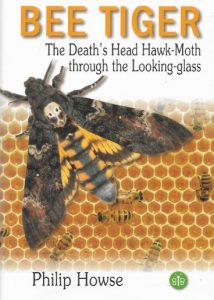Howse, P. 2021, Bee Tiger: The Death’s Head Hawk-Moth through the Looking-glass. Brambleby Books. pp119. ISBN 978-1-908241-62-7 9-781908 24 1627 £13.99
There have been precious few books on a single moth, with the exception of perhaps the Silk moth, Bombyx mori or one of the moon moths or emperors or some of the glamorous day-flying moths. This is not so much an entomological treatise on the Death’s head hawk-moth than a comprehensive discourse on skulls, bones and all interpretations of these patterns and messages as we may see them; it is all in the sub-title, ‘through the looking glass’. Mimicry, which is the author’s passion, and nature’s gift, is full of visual interpretation of the dynamic living world and thus subject to vagaries in our understanding. There is a tendency to anthropomorphosise. And so it is with this hawk-moth. It is a large lumbering moth which has evolved to be a honey thief within honeybee colonies. For a large lumbering moth it must have an acute sense of smell to search out and find honeybee colonies, and as for its large size, it does need this to go deep in a hive and plunder the goods. It may of course be too big for bats to handle, as bats weigh less. Unusually for hawk-moths the death’s head has a very stubby proboscis which it pierces the capped brood and feeds unmolested by the bees. Philip Howse, describes how the morphology of the moth, and its sounds, mimic the piping of the queen bee and it may thus sooth the behaviour of the colony. Of the bright colour of this moth, the contrasting yellows and black we are told mimic the warming colours of wasps and hornets – more for the daytime predators, birds and reptiles than bees. And, as for the scary death’s head, this is also for daytime predators – especially if seen from in front, rather than as we conventionally view a moth as settled or set. The classic medusa head of ancient Rome and Pompeii are invoked, especially with hair entwined with snakes. Photos of heads and skulls are shown, including Picasso’s ‘In Voluptate Mors’. Philip Howse is a poet and he publishes a few of his lines as well as many others, and cites quotations from a host of others including Homer, Faust, Proust, Jung, Darwin and more recently Miriam Rothschild who also was enthralled by the moth. The book is relatively short with nine blank pages at the back (printing problem?) and there is a bibliography, index and glossary of 28 colour plates. There are nine chapters, three of which are linked, the honeybees’ tale, the bat’s tale and the bird’s tale – all expressing how mechanisms have evolved in these groups over millions of years to feast and forage. The author goes to extraordinary lengths to describe the colour vision of birds and then at the end of the chapter to show how birds might view the moth. The same for the bat’s tale chapter, and exposé of the bat’s capabilities in detecting prey on the wing, all backed up with up to date technical research and discoveries. With an exciting cover, and a good in-depth read around the subjects, this book will appeal to entomologists, naturalists and members of the general public. The author is Professor Emeritus in Biological Sciences at the University of Southampton and is the author of a number of general natural history books.
